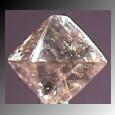| From http://www.cs.unm.edu/~joel/CrystalLab |

|
| This is an uncut diamond. What a difference! |
The typical diamond might not be what you'd think. The uncut diamond (how diamonds are found naturally) looks nothing like a cut diamond (see picture above). Gem cutters use their expertise to cut and polish a diamond in order to make the diamond appear that sparkling way on jewelry. Most diamonds aren't even clear! In fact, many are tinted yellow or filled with inclusions.
Below is a table of the basic data of diamonds:
Chemical Formula: C (carbon)
Moh's Hardness: 10 (the hardest substance!)
Color: Clear (although can have various varieties ranging from yellow to blue to red)
Fracture: Good Cleavage (diamonds are hard, but brittle!) (Cleavage and fracture refer to the manner in which a gem will break when a force is applied to it, so good cleavage means that diamonds can be broken -- which is good in order for the gemcutter to cut the diamond.)
Specific Gravity: 3.51 (remember, anything higher than 1 will sink in water, while anything under 1 will float)
Refractive Index: 2.42 (this is very high -- remember, this is one of the reasons diamonds sparkle)
Luster: Adamantine (According to Hershel Friedman of The Gemstone Kingdom at www.minerals.net, luster describes how a mineral appears to reflect light, particularly how brilliant or dull the mineral is. Adamantine is also known as brilliant or diamondlike, so there is a lot of luster in diamonds!)
Crystal System: Cubic (In other words, diamonds are very symmetrical.)
|

